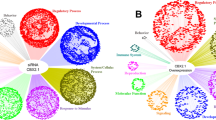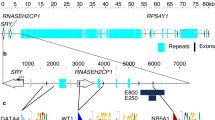Abstract
Duplications of a chromosome Xp21 locus DSS (dosage sensitive sex reversal) are associated with male to female sex reversal. An unusual member of the nuclear hormone receptor superfamily, DAX1, maps to the DSS critical region and is responsible for X-linked adrenal hypoplasia congenita. Here we describe the isolation of the mouse Dax1 gene and its pattern of expression during development. Expression was detected in the first stages of gonadal and adrenal differentiation and in the developing hypothalamus. Moreover, Dax1 expression is down-regulated coincident with overt differentiation in the testis, but persists in the developing ovary. Comparison of the predicted protein products of the human and mouse genes show that specific domains are evolving rapidly. Our results suggest a basis for adrenal insufficiency and hypogonadotropic hypogonadism in males affected by adrenal hypoplasia congenita and are consistent with a role for DAX1 in gonadal sex determination.
This is a preview of subscription content, access via your institution
Access options
Subscribe to this journal
Receive 12 print issues and online access
$209.00 per year
only $17.42 per issue
Buy this article
- Purchase on Springer Link
- Instant access to full article PDF
Prices may be subject to local taxes which are calculated during checkout
Similar content being viewed by others
References
Sinclair, A.H. et al. A gene from the human sex determining region encodes a protein with homology to a conserved DNA binding motif. Nature 346, 240–2454 (1990).
Gubbay, J. et al. A gene mapping to the sex determining region of the mouse Y chromosome is a member of a new family of embryonically expressed genes. Nature 346, 245–250 (1990).
Koopman, P., Gubbay, J., Vivian, N., Goodfellow, P.N. & Lovell-Badge, R. Male development of chromosomally female mice transgenic for Sry . Nature 351, 117–121 (1991).
Goodfellow, P.N. & Lovell-Badge, R. Sex and sex determination in mammals. Annu. Rev. Genet. 27, 71–92 (1993).
Koopman, P., Munsterberg, A., Capel, B., Vivian, N. & Lovell-Badge, R. Expression of a candidate sex determining gene during mouse testis differentiation. Nature 348, 450–452 (1990).
Hacker, A., Capel, B., Goodfellow, P. & Lovell-Badge, R. Expression of Sry, the mouse sex determining gene. Development 121: 1603–1614 (1995).
Jeske, Y.W.A., Bowles, J., Greenfield, A. & Koopman, P. Expression of a linear Sry transcript in the mouse genital ridge. Nature Genet. 10, 480–482 (1995).
Nordqvist, K. & Lovell-Badge, R. Setbacks on the road to sexual fulfilment. Nature Genet. 7, 7–9 (1994).
German, J. et al. Genetically determined sex-reversal in 46,XY humans. Science 202, 53–56 (1978).
Fechner, P.Y. et al. Report of a kindred with X-linked (or autosomal dominant sex-limited) 46, XY partial gonadal dysgenesis. J. Clin. Endocr. Metab. 76, 1248–1252 (1993).
Bardoni, B. et al. A dosage sensitive locus at chromosome Xp21 is involved in male to female sex reversal. Nature Genet. 7: 497–501 (1994).
Dabovic, B. et al. A family of rapidly evolving genes from the sex reversal critical region in Xp21. Mammalian Genome (in the press).
Zanaria, E. et al. An unusual member of the nuclear hormone receptor super-family responsible for X-linked adrenal hypoplasia congenita. Nature 372, 635–641 (1994).
Muscatelli, R. et al. Mutations in the DAX-1 gene give rise to both X-linked adrenal hypoplasia congenita and hypogonadotropic hypogonadism. Nature 372, 672–676 (1994).
Kozak, M. An analysis of 5′-noncoding sequences from 699 vertebrate messenger RNAs. Nucl. Acids Res. 15, 8125–8148 (1987).
Leid, M., Kastner, P. & Chambon, R. Multiplicity generates diversity in the retinoic acid signalling pathways. Trends Biochem. Sci. 17, 427–433 (1992).
Chambon, R. The retinoid signalling pathway: molecular and genetic analysis. Semin. Cell Biol. 5, 115–125 (1994).
Capel, B. & Lovell-Badge, R. The Sry gene and sex determination in mammals. Adv. Dev. Biol. 2, 1–35 (1993).
Seidl, K. & Unsicker, K. The determination of the adrenal medullary cell fate during embryogenesis. Dev. Biol. 136, 481–490 (1989).
Rogler, L.E. & Pintar, J.E. Expression of the P450 side-chain cleavage and adrenodoxin genes begins during early stages of adrenal cortex development. Mol. Endocr. 7, 453–461 (1993).
Buehr, M., Gu, S. & McLaren, A. Mesonephric contribution to testis differentiation in the fetal mouse. Developement 117, 273–281 (1992).
Whitfield, S., Lovell-Badge, R. & Goodfellow, P.N. Rapid sequence evolution ofthe sex determining gene SRY. Nature 364, 713–715 (1993).
Tucker, P.K. & Lundrigan, B.L. Rapid evolution of the sex determining locus in Old World mice and rats. Nature 364, 715–717 (1993).
Foster, J.W. et al. Campomelic dysplasia and autosomal sex reversal caused by mutations in an SRY-related gene. Nature 372, 525–530 (1994).
Wagner, T. et al. Autosomal sex reversal and campomelic dysplasia are caused by mutations in and around the SRY-related gene SOX9 . Cell 79, 1111–1120 (1994).
Wright, E. et al. The Sry-related gene Sox-9 is expressed during chondrogenesis in mouse embryos. Nature Genet. 9, 15–20 (1995).
Kreidberg, J.A. et al. Wt-1 is required for for early kidney development. Cell 74, 679–691 (1993).
Mueller, R.F., Denys-Drash syndrome. J. Med. Genet. 31, 471–177 (1994).
Luo, X. et al. A cell-specific nuclear receptor is essential for adrenal and gonadal development and sexual differentiation. Cell 77, 481–490 (1994).
Shen, W.-H. et al. Nuclear receptor steroidogenic factor 1 regulates the Mullerian inhibiting substance gene: a link to the sex determination pathway. Cell 77: 651–661 (1994).
Bouget, W., Ruff, M., Chambon, P., Gronemeyer, H. & Moras, D. Crystal structure of the ligand-binding domain of the human nuclear receptor RXR-α. Nature 375, 377–382 (1995).
Kletter, G.B., Gorski, J.L. & Kelch, R.P. Congenital adrenal hypoplasia and isolated gonadotropin deficiency. Trends Endocr. Met. 2, 123–128 (1991).
Ingraham, H.A. et al. The nuclear receptor steroidogenic factor 1 acts at multiple levels ofthe reproductive axis. Genes Dev. 8, 2302–2312 (1994).
Ikeda, Y., Luo, X., Abbud, R., Nilson, J. & Parker, K.L. The nuclear receptor steroidogenic factor 1 is essential for the formation of the ventromedial hypothalamic nucleus. Mol. Endocr. 9, 478–486 (1995).
Lovell-Badge, R. & Hacker, A. The molecular genetics of Sry and its role in mammalian sex determination. Phil. Trans. R. Soc. Lond. B. 350, 205–214 (1995).
Haqq, C.M. et al. Molecular basis of mammalian sexual determination: activation of Mullerian inhibiting substance gene expression by SRY . Science 266, 1494–1500 (1994).
Sambrook, J., Fritsch, E.F. & Maniatis, T. Molecular cloning: A Laboratory Manual 2nd edn. (Cold Spring Harbor Laboratory Press, New York, 1989).
Wilkinson, D. & Nieto, M.A. Detection of messenger RNA by in situ hybridization to tissue sections and whole mounts, in Guide to Techniques in Mouse Development Methods in Enzymology, Vol. 225 (eds Wassarman, P.M. & DePamphilis, M.L.) 361–372 (Academic Press, New York, 1993).
Chirgwin, J. et al. Isolation of biologically active ribonucleic acid from sources enriched in ribonuclease. Biochemistry 18, 5294–5299 (1979).
Dresser, D.W., Hacker, A., Lovell-Badge, R. & Guerrier, D. The genes for a spliceosome protein (SAP62) and the anti-Mullerian (AMH) are contiguous. Hum. Mol. Genet. 4, 1613–1618 (1995).
Author information
Authors and Affiliations
Rights and permissions
About this article
Cite this article
Swain, A., Zanaria, E., Hacker, A. et al. Mouse Dax1 expression is consistent with a role in sex determination as well as in adrenal and hypothalamus function. Nat Genet 12, 404–409 (1996). https://doi.org/10.1038/ng0496-404
Received:
Accepted:
Issue Date:
DOI: https://doi.org/10.1038/ng0496-404
This article is cited by
-
Mammalian X-chromosome inactivation: proposed role in suppression of the male programme in genetic females
Journal of Genetics (2022)
-
Leydig Cell–Specific DAX1-Deleted Mice Has Higher Testosterone Level in the Testis During Pubertal Development
Reproductive Sciences (2022)
-
Spontaneous fertility and variable spectrum of reproductive phenotype in a family with adult-onset X-linked adrenal insufficiency harboring a novel DAX-1/NR0B1 mutation
BMC Endocrine Disorders (2020)
-
Report: central diabetes insipidus and schwannoma in a male with X-linked congenital adrenal hypoplasia
BMC Endocrine Disorders (2020)
-
Gene dosage of DAX-1, determining in sexual differentiation: duplication of DAX-1 in two sisters with gonadal dysgenesis
Molecular Biology Reports (2019)



